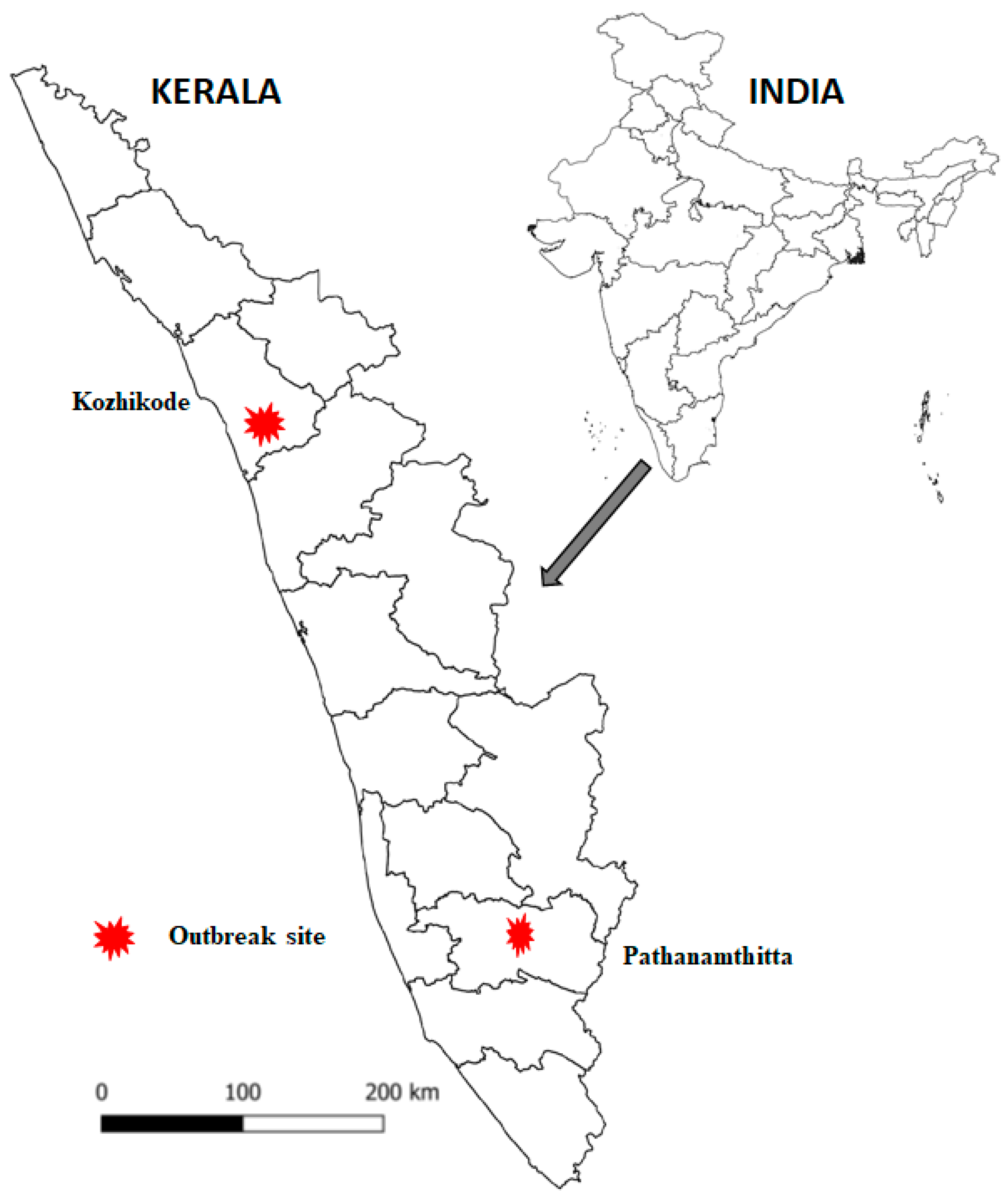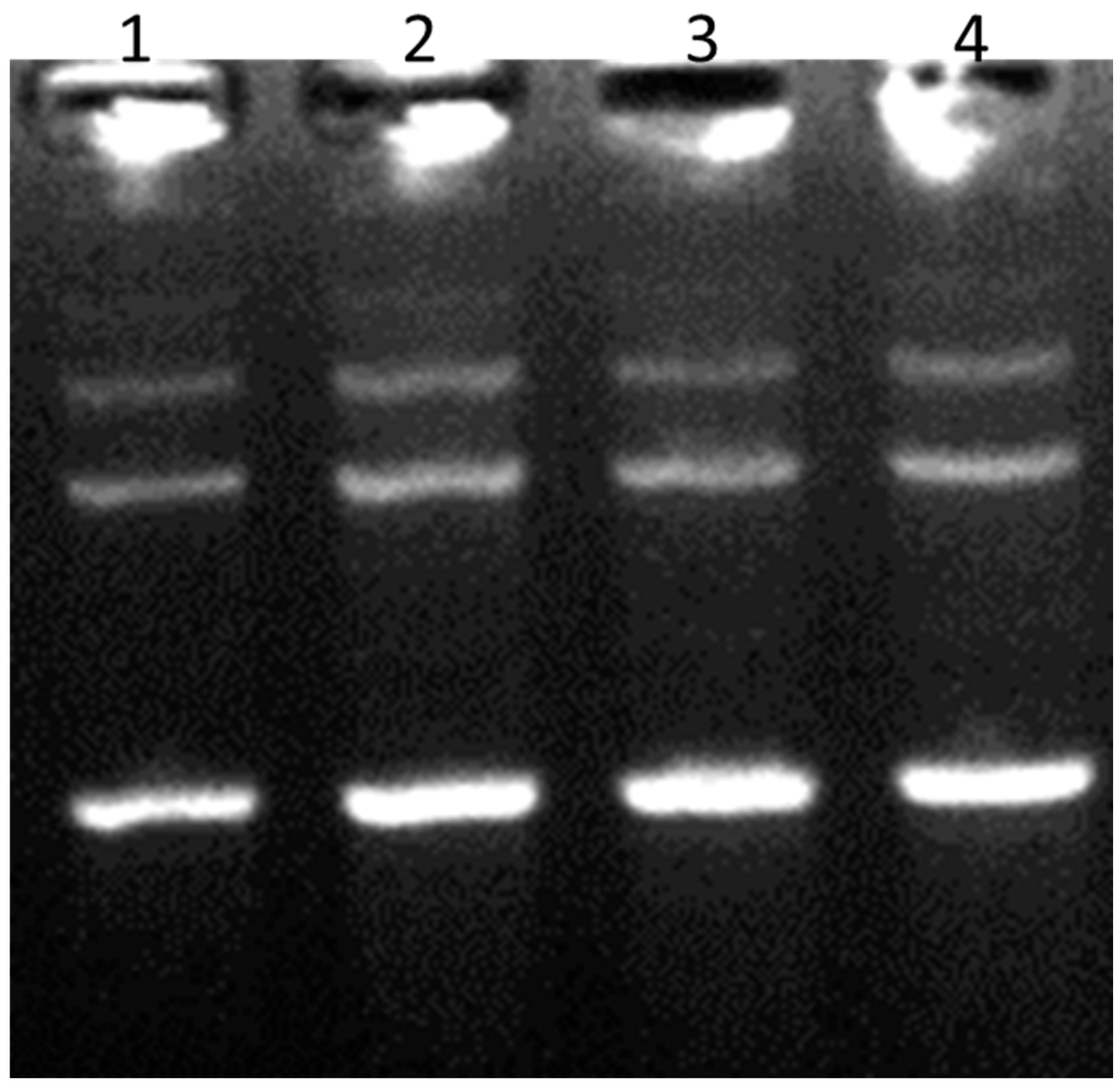Multiple Drug-Resistant Vibrio Cholerae Responsible for Cholera Outbreak among Migrant Domestic Workers in Kerala, South India †
Abstract
1. Introduction
2. Materials and Methods
3. Results & Discussion
Acknowledgments
Conflicts of Interest
References
- Taylor, D.L.; Kahawita, T.M.; Cairncross, S.; Ensink, J.H.J. The Impact of Water, Sanitation and Hygiene Interventions to Control Cholera: A Systematic Review. PLoS ONE 2015, 10, e0135676. [Google Scholar] [CrossRef] [PubMed]
- Snow, J. On the Mode of Communication of Cholera, 2nd ed.; John Churchill: London, UK, 1855. [Google Scholar]
- World Health Organization. WHO Global Water, Sanitation and Hygiene: Annual Report 2018; World Health Organization: Geneva, Switzerland, 2019. [Google Scholar]
- Ackers, M.-L.; Quick, R.E.; Drasbek, C.J.; Hutwagner, L.; Tauxe, R.V. Are there national risk factors for epidemic cholera? The correlation between socioeconomic and demographic indices and cholera incidence in Latin America. Int. J. Epidemiol. 1998, 27, 330–334. [Google Scholar] [CrossRef] [PubMed]
- Colwell, R.R. Global Climate and Infectious Disease: The Cholera Paradigm. Science 1996, 274, 2025–2031. [Google Scholar] [CrossRef] [PubMed]
- Ali, M.; Gupta, S.S.; Arora, N.; Khasnobis, P.; Venkatesh, S.; Sur, D.; Nair, G.B.; Sack, D.A.; Ganguly, N.K. Identification of burden hotspots and risk factors for cholera in India: An observational study. PLoS ONE 2017, 12, e0183100. [Google Scholar] [CrossRef] [PubMed]
- Sub-national HDI—Subnational HDI—Global Data Lab. Available online: https://globaldatalab.org/shdi/shdi/IND/?interpolation=0&extrapolation=0&nearest_real=0&years=2015 (accessed on 31 March 2020).
- Kitaoka, M.; Miyata, S.T.; Unterweger, D.; Pukatzki, S. Antibiotic resistance mechanisms of Vibrio cholerae. J. Med. Microbiol. 2011, 60, 397–407. [Google Scholar] [CrossRef] [PubMed]
- Wilson, K. Preparation of Genomic DNA from Bacteria. Curr. Protoc. Mol. Biol. 2001, 56, 2.4.1–2.4.5. [Google Scholar] [CrossRef] [PubMed]
- Sneha, K.; Anas, A.; Jayalakshmy, K.; Jasmin, C.; Das, P.V.; Pai, S.S.; Pappu, S.; Nair, M.; Muraleedharan, K.; Sudheesh, K.; et al. Distribution of multiple antibiotic resistant Vibrio spp. across Palk Bay. Reg. Stud. Mar. Sci. 2016, 3, 242–250. [Google Scholar] [CrossRef]
- Zhu, L.; Xu, H.; Zhang, Y.; Fu, G.; Wu, P.Q.; Li, Y. BOX-PCR and PCR-DGGE analysis for bacterial diversity of a naturally fermented functional food (Enzyme®). Food Biosci. 2014, 5, 115–122. [Google Scholar] [CrossRef]
- Swaddiwudhipong, W.; Ngamsaithong, C.; Peanumlom, P.; Hannarong, S. An outbreak of cholera among migrants living in a Thai-Myanmar border area. J. Med Assoc. Thail. = Chotmaihet thangphaet 2008, 91, 1433–1440. [Google Scholar]
- Siddique, A.K. Cholera epidemic among Rwandan refugees: Experience of ICDDR, B in Goma, Zaire. Glimpse (Dhaka, Bangladesh) 1994, 16, 3–4. [Google Scholar] [PubMed]
- Naficy, A.; Rao, M.R.; Paquet, C.; Antona, D.; Sorkin, A.; Clemens, J.D. Treatment and Vaccination Strategies to Control Cholera in Sub-Saharan Refugee Settings: A Cost-effectiveness Analysis. JAMA 1998, 279, 521–525. [Google Scholar] [CrossRef] [PubMed]
- Saikia, D. Migrant Workers in Kerala: A Study on Their Socio-Economic Conditions. SSRN Electron. J. 2010, 11, 29–43. [Google Scholar] [CrossRef]
- Krishna, K.; Veettil, V.P.; Anas, A.; Nair, S. Hydrological regulation of Vibrio dynamics in a tropical monsoonal estuary: A classification and regression tree approach. Environ. Sci. Pollut. Res. 2020, 1–14. [Google Scholar] [CrossRef] [PubMed]
- Mani, S.K.; Kanjur, R.; Raj, B.S.; Surekha, I.S.; Singh, I.S.B. Reed RH Solar Disinfection as a Management Strategy for Drinking Water Treatment in Rural Households & in Natural Disasters. Available online: https://www.researchgate.net/publication/257840643_Solar_disinfection_as_a_management_strategy_for_drinking_water_treatment_in_rural_households_in_natural_disasters (accessed on 24 August 2020).
- Panikar, P.G.K. Fall in Mortality Rates in Kerala: An Explanatory Hypothesis. Econ. Political Wkly. 1975, 10, 1811–1818. [Google Scholar]
- Sabeena, F.; Thirivikramji, G.; Radhakutty, G.; Indu, P.; Singh, D.V. In vitro susceptibility of Vibrio cholerae O1 biotype El Tor strains associated with an outbreak of cholera in Kerala, Southern India. J. Antimicrob. Chemother. 2001, 47, 361–362. [Google Scholar] [CrossRef] [PubMed]
- Mandal, J.; Sangeetha, V.; Ganesan, V.; Parveen, M.; Preethi, V.; Harish, B.N.; Srinivasan, S.; Parija, S.C. Third-Generation Cephalosporin-Resistant Vibrio cholerae, India. Emerg. Infect. Dis. 2012, 18, 1326–1328. [Google Scholar] [CrossRef] [PubMed]
- Garg, P.; Sinha, S.; Chakraborty, R.; Bhattacharya, S.K.; Nair, G.B.; Ramamurthy, T.; Takeda, Y. Emergence of Fluoroquinolone-Resistant Strains of Vibrio cholerae O1 Biotype El Tor among Hospitalized Patients with Cholera in Calcutta, India. Antimicrob. Agents Chemother. 2001, 45, 1605–1606. [Google Scholar] [CrossRef] [PubMed]
- Kumar, N.A. Vulnerability of Migrants and Responsiveness of the State: The Case of Unskilled Migrant Workers in Kerala, India; (CSES Working Paper Series No.26); Centre for Soci-Economic and Environmental Studies: Kochin, India, 2011. [Google Scholar]



| Chemical class | Antibiotics | Source of Vibrio cholerae | |||
|---|---|---|---|---|---|
| Pathanamthitta | Kozhikode | Kozhikode | Kozhikode | ||
| Penicillin | Ampicillin | R | R | R | R |
| Cephalosporins | Cephalexin | R | R | R | R |
| Cefoxitin | R | R | R | R | |
| Ceftriaxone | R | R | R | R | |
| Cefapime | R | R | R | R | |
| Carbapenem | Imipenem | R | R | R | R |
| Tetracycline | Tetracycline | S | S | S | S |
| Aminoglycoside | Gentamicin | R | R | S | R |
| Macrolides | Erythromycin | R | R | R | R |
| Chloramphenicol | Chloramphenicol | R | R | R | R |
| Fluoroquinolones | Nalidixic acid | R | R | R | R |
| Norfloxacin | R | R | R | R | |
| Gatifloxacin | R | R | S | R | |
| Moxifloxacin | R | R | S | R | |
| Sulfonamide | Trimethoprim | R | R | R | R |
Publisher’s Note: MDPI stays neutral with regard to jurisdictional claims in published maps and institutional affiliations.
|
© 2021 by the authors. Licensee MDPI, Basel, Switzerland. This article is an open access article distributed under the terms and conditions of the Creative Commons Attribution (CC BY) license (https://creativecommons.org/licenses/by/4.0/).
Share and Cite
Krishna, K.; Anas, A.; Kuttan, S.P.; Vijayakumar, S.; Chekidhenkuzhiyil, J.; Philomina, B.; Kurien, S. Multiple Drug-Resistant Vibrio Cholerae Responsible for Cholera Outbreak among Migrant Domestic Workers in Kerala, South India. Proceedings 2020, 66, 26. https://doi.org/10.3390/proceedings2020066026
Krishna K, Anas A, Kuttan SP, Vijayakumar S, Chekidhenkuzhiyil J, Philomina B, Kurien S. Multiple Drug-Resistant Vibrio Cholerae Responsible for Cholera Outbreak among Migrant Domestic Workers in Kerala, South India. Proceedings. 2020; 66(1):26. https://doi.org/10.3390/proceedings2020066026
Chicago/Turabian StyleKrishna, Kiran, Abdulaziz Anas, Sreelakshmi Parakkaparambil Kuttan, Syamkumar Vijayakumar, Jasmin Chekidhenkuzhiyil, Beena Philomina, and Sobha Kurien. 2020. "Multiple Drug-Resistant Vibrio Cholerae Responsible for Cholera Outbreak among Migrant Domestic Workers in Kerala, South India" Proceedings 66, no. 1: 26. https://doi.org/10.3390/proceedings2020066026
APA StyleKrishna, K., Anas, A., Kuttan, S. P., Vijayakumar, S., Chekidhenkuzhiyil, J., Philomina, B., & Kurien, S. (2020). Multiple Drug-Resistant Vibrio Cholerae Responsible for Cholera Outbreak among Migrant Domestic Workers in Kerala, South India. Proceedings, 66(1), 26. https://doi.org/10.3390/proceedings2020066026






